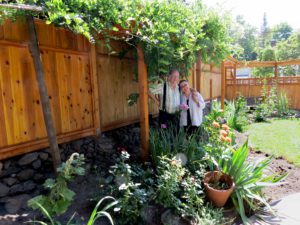Aug. 13 Column: Kurt Madison Profile

My husband and I have lived on a 5-acre property for 27 years now. Even though we’ll want to downsize at some point, neither of us can picture ourselves on a tiny city lot! Well, Master Gardener colleague Kurt Madison and his wife Margot Casstevens have made the move from 10 acres to a city lot, and are adapting quite nicely.
That’s the subject of my garden column today. Kurt graciously offered to share this thoughts on transforming a city lot into a landscape that reflects who they are. Both Kurt and Margot are professional artists and fine art instructors at Spokane Falls Community College. Here is a link to my column in today’s edition of The Spokesman-Review: Tips help homeowners transform existing landscapes. (or you can read my column lower in this post)
This week’s video topic is near and dear to my heart: raised bed gardening. I teach classes on this marvelous gardening method. In the video, you’ll learn some of the key reasons why I love it so much. There’s also information on how to build raised beds. Enjoy!
Garden column: Kurt Madison
by Susan Mulvihill
It’s fair to say that downsizing from 10 acres to a standard city lot would be an adjustment for anyone — but especially for two dedicated gardeners. Kurt Madison and his wife, Margot Casstevens, have turned that adjustment into a learning experience that others can benefit from.
Madison and Casstevens are both professional artists and fine art instructors at Spokane Falls Community College. He first became interested in gardening in the 1970s while living in Austin, Texas.
“I had a large circle of friends and we tended to do everything cooperatively,” he explained. “We rototilled everybody’s yards and grew organic vegetables.”
After relocating to Chicago, he became certified as a Master Gardener. The couple later moved to Scotland for three years, where Madison learned estate gardening and English gardening techniques. Following that, they moved to Indiana for another three years and eventually moved to a 10-acre property in south Greenacres in 2000. They’ve been in the Spokane area ever since.
“We had a big lawn and planted huge swaths of plants,” he said of their Greenacres garden. “Deer and other pests were a problem and watering everything was a challenge.”
Three years ago, they moved to a small South Hill lot. Other than missing how peaceful it was on their rural property, Madison is happy with the change.
“Overall, there are less obligations,” he admitted. “I have an irrigation system now and am really pleased that I can water everything with 50 feet of hose. And it’s nice not to have to deal with deer anymore.”
They have been gradually transforming the previous owner’s landscape into their new garden. First on the list was removing quaking aspen trees that were taking over the backyard. They also had a large fir tree removed and expanded the planting beds.
Madison and Casstevens are currently building an attractive fence around their backyard that incorporates a pergola for wisteria to grow on. They’ve added new plants as well.
“We are specimen-driven so want to have plants that folks aren’t used to seeing,” Madison said. “We want fragrance and a visually-intriguing garden.”
Putting their unique stamp on the landscape has allowed Madison to formulate tips for others who have recently moved, or are contemplating a move:
- “Try to leave the existing landscape alone for a year. See what’s there. You have no idea how many tulips are in the ground and you need a year to understand what’s going to come up. However, you do need to get rid of any egregious faults such as dead or troublesome trees.”
- “The next step is to clean the ‘lines’ of the garden such as pathways and edges of beds. That doesn’t necessarily refer to straight lines; it could be rounded or undulating lines that define areas of the garden. Cleaning them up can do amazing things to any garden environment.”
- “Eliminate plants that could be a problem or types you don’t personally care for.”
- “Remember that you save money, time and effort — and get better quality — by creating a master plan. Measure your property and call 811 to locate utilities before you do any digging. When you draw up plans, it’s so much easier to visualize what you have in mind.”
In addition to providing these pointers, Kurt Madison enjoys doing garden design consultations. He can be contacted via email at kraymn@icloud.com.

